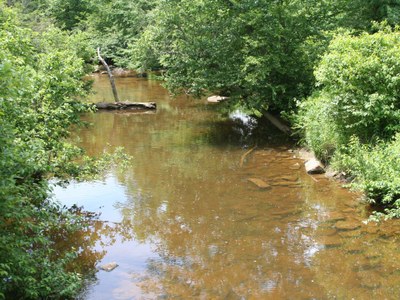Regional Brook Trout Threats
Northern Region
The last, best stronghold for Brook Trout in the eastern United States is in the northern region. More intact populations are found in this region than in the other two combined. It is the only region that contains all four distinct adaptations of Brook Trout: riverine, stream, lake dwelling and sea-run. Although the north has large tracts of uninhabited public and private land, Brook Trout are severely threatened by human impacts.
Challenges:
Sediment and high water temperature caused by land use changes

Exotic species such as smallmouth bass and non-native trout
Management Priorities:
Protect healthy populations
Reduce habitat fragmentation
Improve water quality
Build partnerships
Mid-Atlantic Region
This region has seen the greatest decline in Brook Trout. Within the mid-Atlantic region, Brook Trout populations are scattered primarily in headwater streams originating in the mountains and foothills that span the region. Brook Trout also inhabit the spring-fed limestone creeks that are prevalent in central Pennsylvania. The most southern occurrence of piedmont Brook Trout occurs in Maryland. Much of this land area has been impacted by poor agricultural and forest land use practices, especially in the watersheds of the ridge and valley landforms common to this region.
Where they occur, acid precipitation and abandoned mine drainage severely impact Mid-Atlantic streams. There are currently no permanent methods to remediate the effects of acid in eastern lakes and streams. The most common management strategy is periodically adding limestone to streams. Source remediation can be successful and is preferred in treating mine drainages.
Growth of mid-Atlantic cities also has contributed to the loss of Brook Trout. This development has resulted in warm water temperatures due to loss of forest shading along streams, heated runoff from paved surfaces, over-widening streams, and loss of physical habitat and cover in streams.
Challenges:
Poor agricultural practices
Urbanization
Invasive species
Acid effects from mine drainage and precipitation
Management Priorities:
Protect healthy Brook Trout populations
Improve water quality
Promote and restore riparian forest
Remove or contain invasive fish species
Southern Region
Brook Trout no longer occur in 40% of their historical range in the region. Researchers have identified a unique strain of Brook Trout called the southern Appalachian Brook Trout (SABT). This heritage strain is the keystone species of the southern Appalachians and is an important biologic, economic and recreational asset to the region. One special southern habitat is the valley spring creeks, where Brook Trout loss is nearly 100%. The remaining Brook Trout are generally isolated in the high elevation headwater streams located mostly on public lands.
Challenges:
Agriculture practices that increase sediment and water temperature
Invasive species
Urbanization
Management Priorities:
Protect existing Brook Trout from competition with invasive fish species
Improve existing Brook Trout habitat
Minimize land use impacts
Document Actions





